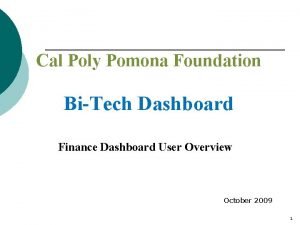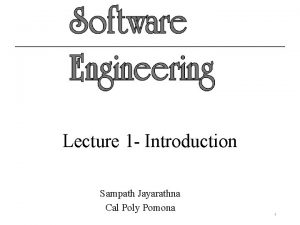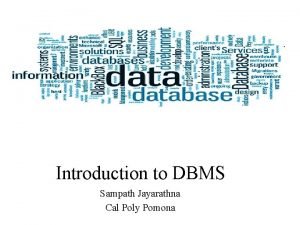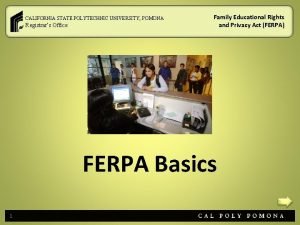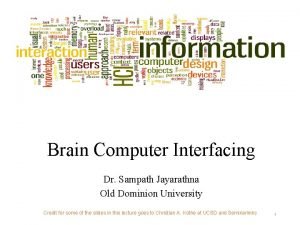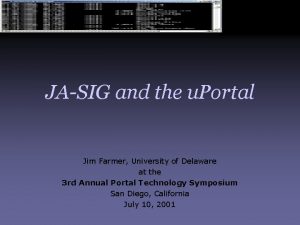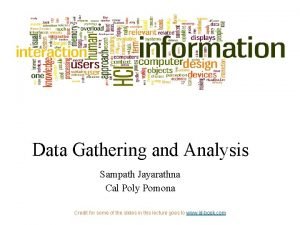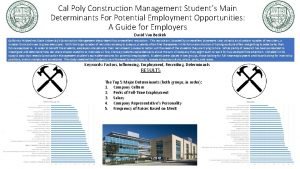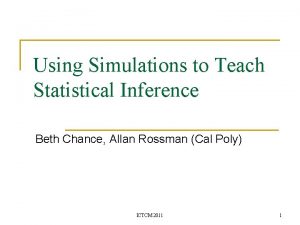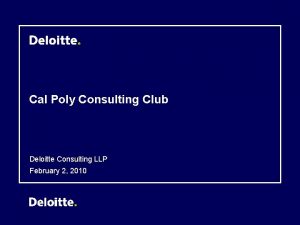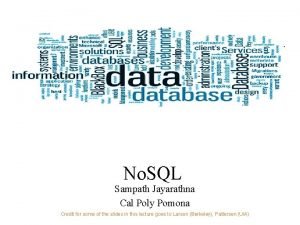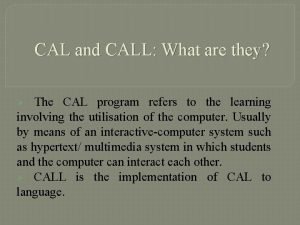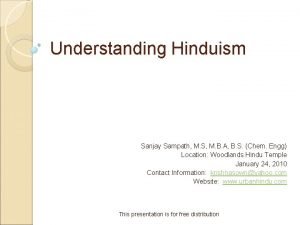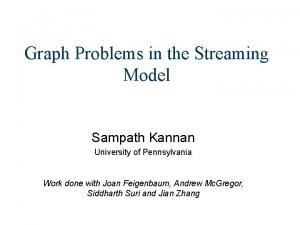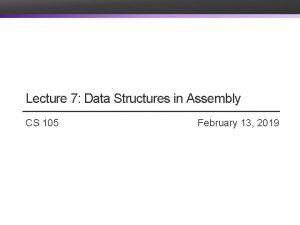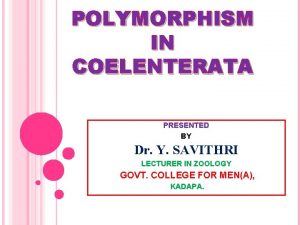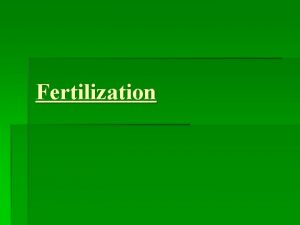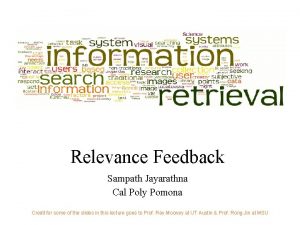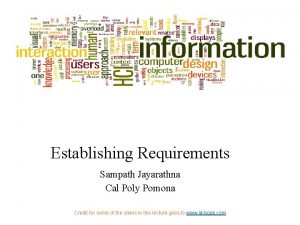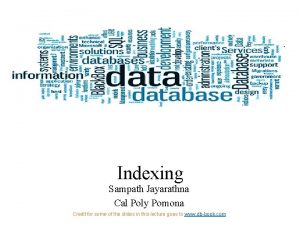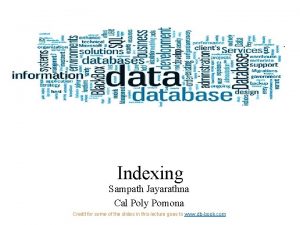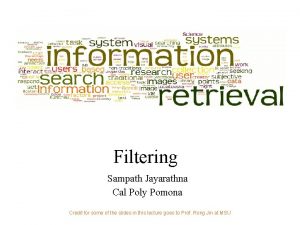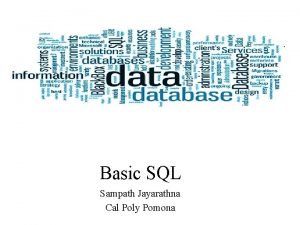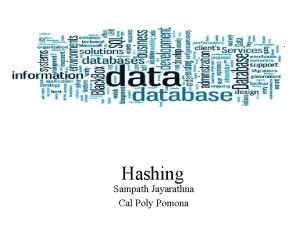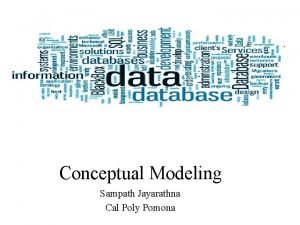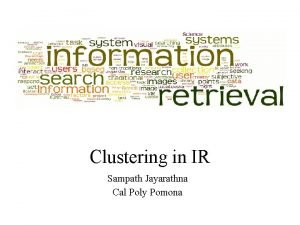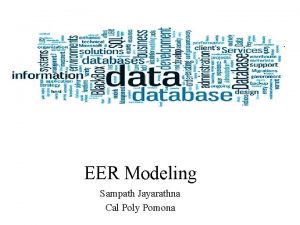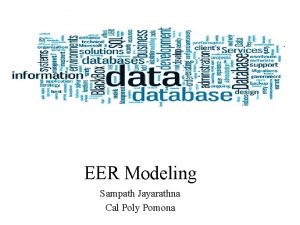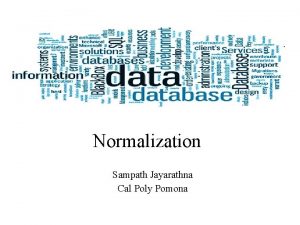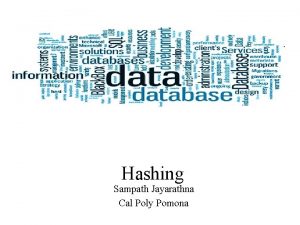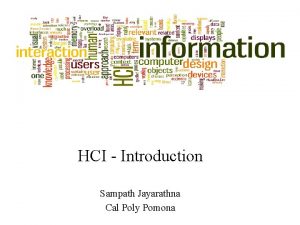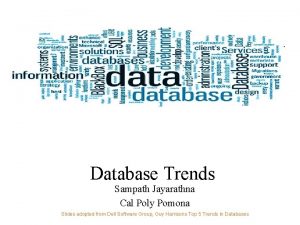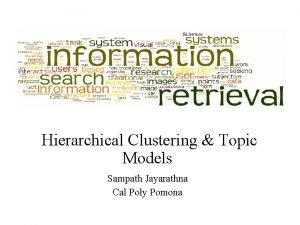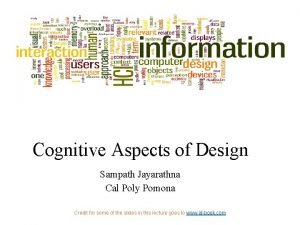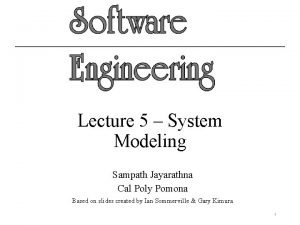No SQL Sampath Jayarathna Cal Poly Pomona Credit
































- Slides: 32

No. SQL Sampath Jayarathna Cal Poly Pomona Credit for some of the slides in this lecture goes to Larson (Berkeley), Pattersen (Ui. A)

No. SQL! No. SQL databases are currently a hot topic in some parts of computing, with over a hundred different No. SQL databases.

RDBMS Characteristics • Data stored in columns and tables • Relationships represented by data • Data Manipulation Language • Data Definition Language • Transactions • Abstraction from physical layer • Applications specify what, not how • Physical layer can change without modifying applications • Create indexes to support queries • In Memory databases

Transactions – ACID Properties • Atomic – All of the work in a transaction completes (commit) or none of it completes • a transaction to transfer funds from one account to another involves making a withdrawal operation from the first account and a deposit operation on the second. If the deposit operation failed, you don’t want the withdrawal operation to happen either. • Consistent – A transaction transforms the database from one consistent state to another consistent state. Consistency is defined in terms of constraints. • a database tracking a checking account may only allow unique check numbers to exist for each transaction • Isolated – The results of any changes made during a transaction are not visible until the transaction has committed. • a teller looking up a balance must be isolated from a concurrent transaction involving a withdrawal from the same account. Only when the withdrawal transaction commits successfully and the teller looks at the balance again will the new balance be reported. • Durable – The results of a committed transaction survive failures • A system crash or any other failure must not be allowed to lose the results of a transaction or the contents of the database. Durability is often achieved through separate transaction logs that can "re-create" all transactions from some picked point in time (like a backup).

No. SQL Definition From www. nosql-database. org: Next Generation Databases mostly addressing some of the points: being non-relational, distributed, opensource and horizontal scalable. The original intention has been modern web-scale databases. The movement began early 2009 and is growing rapidly. Often more characteristics apply as: schema-free, easy replication support, simple API, eventually consistent / BASE (not ACID), a huge data amount, and more.

No SQL? • No. SQL stands for: • No Relational • No RDBMS • Not Only SQL • No. SQL is an umbrella term for all databases and data stores that don’t follow the RDBMS principles • A class of products • A collection of several (related) concepts about data storage and manipulation • Often related to large data sets

Where does No. SQL come from? • Non-relational DBMSs are not new • But No. SQL represents a new incarnation • Due to massively scalable Internet applications • Based on distributed and parallel computing • Development • Starts with Google • First research paper published in 2003 • Continues also thanks to Lucene's developers/Apache (Hadoop) and Amazon (Dynamo) • Then a lot of products and interests came from Facebook, Netfix, Yahoo, e. Bay, Hulu, IBM, and many more

No. SQL and Big Data • No. SQL comes from Internet, thus it is often related to the “big data” concept • How much big are “big data”? • Over few terabytes Enough to start spanning multiple storage units • Challenges • Efficiently storing and accessing large amounts of data is difficult, even more considering fault tolerance and backups • Manipulating large data sets involves running immensely parallel processes • Managing continuously evolving schema and metadata for semi-structured and un-structured data is difficult

Why are RDBMS no suitable for Big Data • The context is Internet • RDBMSs assume that data are • Dense • Largely uniform (structured data) • Data coming from Internet are • Massive and sparse • Semi-structured or unstructured • With massive sparse data sets, the typical storage mechanisms and access methods get stretched

No. SQL Distinguishing Characteristics • Large data volumes • Google’s “big data” • Scalable replication and distribution • Potentially thousands of machines • Potentially distributed around the world • Queries need to return answers quickly • Mostly query, few updates • Asynchronous Inserts & Updates • Schema-less • ACID transaction properties are not needed – BASE • CAP Theorem • Open source development

No. SQL Database Types Discussing No. SQL databases is complicated because there a variety of types: • Sorted ordered Column Store • Optimized for queries over large datasets, and store columns of data together, instead of rows • Document databases: • pair each key with a complex data structure known as a document. • Key-Value Store : • are the simplest No. SQL databases. Every single item in the database is stored as an attribute name (or 'key'), together with its value. • Graph Databases : • are used to store information about networks of data, such as social connections.

Document Databases • Documents • Loosely structured sets of key/value pairs in documents, e. g. , XML, JSON, BSON • Encapsulate and encode data in some standard formats or encodings • Are addressed in the database via a unique key • Documents are treated as a whole, avoiding splitting a document into its constituent name/value pairs • Allow documents retrieving by keys or contents • Notable for: • Mongo. DB (used in Four. Square, Github, and more) • Couch. DB (used in Apple, BBC, Canonical, Cern, and more)

Document Store • The central concept is the notion of a "document“ which corresponds to a row in RDBMS. • A document comes in some standard formats like JSON (BSON). • Documents are addressed in the database via a unique key that represents that document. • The database offers an API or query language that retrieves documents based on their contents. • Documents are schema free, i. e. , different documents can have structures and schema that differ from one another. (An RDBMS requires that each row contain the same columns. ) 13

Document Databases, JSON { _id: Object. Id("51156 a 1 e 056 d 6 f 966 f 268 f 81"), type: "Article", author: "Derick Rethans", title: "Introduction to Document Databases with Mongo. DB", date: ISODate("2013 -04 -24 T 16: 26: 31. 911 Z"), body: "This arti…" }, { _id: Object. Id("51156 a 1 e 056 d 6 f 966 f 268 f 82"), type: "Book", author: "Derick Rethans", title: "php|architect's Guide to Date and Time Programming with PHP", isbn: "978 -0 -9738621 -5 -7" }

Key/Value stores • Store data in a schema-less way • Store data as maps • Hash. Maps or associative arrays • Provide a very efficient average running time algorithm for accessing data • Notable for: • • • Couchbase (Zynga, Vimeo, NAVTEQ, . . . ) Redis (Craiglist, Instagram, Stack. Overfow, fickr, . . . ) Amazon Dynamo (Amazon, Elsevier, IMDb, . . . ) Apache Cassandra (Facebook, Digg, Reddit, Twitter, . . . ) Voldemort (Linked. In, e. Bay, …) Riak (Github, Comcast, Mochi, . . . )

Sorted Ordered Column-Oriented Stores • Data are stored in a column-oriented way • • • Data efficiently stored Avoids consuming space for storing nulls Columns are grouped in column-families Data isn’t stored as a single table but is stored by column families Unit of data is a set of key/value pairs • Identified by “row-key” • Ordered and sorted based on row-key • Notable for: • Google's Bigtable (used in all Google's services) • HBase (Facebook, Stumble. Upon, Hulu, Yahoo!, . . . )

Graph Databases • Graph-oriented • Everything is stored as an edge, a node or an attribute. • Each node and edge can have any number of attributes. • Both the nodes and edges can be labelled. • Labels can be used to narrow searches. 17

Property Graph Model ITH W _ S L TRAVE LOVES WITH _ S L E TRAV first name: Rose late name: Tyler TRA V ELS_ IN name: the Doctor age: 907 species: Time Lord ED OW 963 R R r: 1 O B ea y vehicle: tardis model: Type 40 Slide copied from a presentation made by Jim Webber Neo 4 J

Dealing with Big Data and Scalability • Issues with scaling up when the dataset is just too big • RDBMS were not designed to be distributed • Traditional DBMSs are best designed to run well on a “single” machine • Larger volumes of data/operations requires to upgrade the server with faster CPUs or more memory known as ‘scaling up’ or ‘Vertical scaling’ • No. SQL solutions are designed to run on clusters or multinode database solutions • Larger volumes of data/operations requires to add more machines to the cluster, Known as ‘scaling out’ or ‘horizontal scaling’ • Different approaches include: • Master-slave • Sharding (partitioning)

Scaling RDBMS – Master/Slave • Master-Slave • All writes are written to the master. All reads performed against the replicated slave databases • Critical reads may be incorrect as writes may not have been propagated down • Large data sets can pose problems as master needs to duplicate data to slaves

Sharding • Any DB distributed across multiple machines needs to know in what machine a piece of data is stored or must be stored • A sharding system makes this decision for each row, using its key • The main issue is to decide a rule for mapping any key to the corresponding shard • The rule must not introduce too much extra complexity and lookup cost • The rule must be flexible to adapt to changes in the cluster and data amount growing • Different sharding approaches: • Vertical Partitioning: Have tables related to a specific feature sit on their own server. May have to rebalance or reshard if tables outgrow server. • Range-Based Partitioning: When single table cannot sit on a server, split table onto multiple servers. Split table based on some critical value range. • Key or Hash-Based partitioning: Use a key value in a hash and use the resulting value as entry into multiple servers. • Directory-Based Partitioning: Have a lookup service that has knowledge of the partitioning scheme. This allows for the adding of servers or changing the partition scheme without changing the application.

No. SQL, No ACID • RDBMSs are based on ACID (Atomicity, Consistency, Isolation, and Durability) properties • No. SQL • Does not give importance to ACID properties • In some cases completely ignores them • In distributed parallel systems it is difficult/impossible to ensure ACID properties • Long-running transactions don't work because keeping resources blocked for a long time is not practical

BASE Transactions • Acronym contrived to be the opposite of ACID • Basically Available, • Soft state, • Eventually Consistent • Characteristics • Weak consistency – stale data OK • Availability first • Best effort • Approximate answers OK • Aggressive (optimistic) • Simpler and faster

CAP Theorem A congruent and logical way for assessing the problems involved in assuring ACID-like guarantees in distributed systems is provided by the CAP theorem At most two of the following three can be maximized at one time • Consistency • Each client has the same view of the data • Availability • Each client can always read and write • Partition tolerance • System works well across distributed physical networks

CAP Theorem: Two out of Three • CAP theorem – At most two properties on three can be addressed • The choices could be as follows: 1. Availability is compromised but consistency and partition tolerance are preferred over it 2. The system has little or no partition tolerance. Consistency and availability are preferred 3. Consistency is compromised but systems are always available and can work when parts of it are partitioned

CAP Theorem: Two out of Three • CAP theorem – At most two properties on three can be addressed • The choices could be as follows: 1. Availability is compromised but consistency and partition tolerance are preferred over it 2. The system has little or no partition tolerance. Consistency and availability are preferred 3. Consistency is compromised but systems are always available and can work when parts of it are partitioned

CAP Theorem: Two out of Three • CAP theorem – At most two properties on three can be addressed • The choices could be as follows: 1. Availability is compromised but consistency and partition tolerance are preferred over it 2. The system has little or no partition tolerance. Consistency and availability are preferred 3. Consistency is compromised but systems are always available and can work when parts of it are partitioned

Option 1: compromising on availability • Usual choice for transactional RDBMS under horizontal scaling • Availability is affected by many factors, including: • • Delays due to network lag Communication bottlenecks Resource starvation Hardware failure leading to partitioning

Option 2: compromising on partition tolerance • Modern interpretation of theorem is: during a network partition, a distributed system must choose either Consistency or Availability • Because a system that is not Partition-tolerant will, by definition, be forced to give up Consistency or Availability during a partition • Werner Vogels, Amazon CTO • “An important observation is that in larger distributed-scale systems, network partitions are a given; therefore, consistency and availability cannot be achieved at the same time. ”

Consistency or Availability • Consistency and Availability is not “binary” decision • AP systems relax consistency in favor of availability – but are not inconsistent • CP systems sacrifice availability for consistency- but are not unavailable • This suggests both AP and CP systems can offer a degree of consistency, and availability, as well as partition tolerance C A P

Option 3: compromising on Consistency • Dropping strong consistency we get weak consistency • We accept “eventual consistency” • Eventual consistency could be interpreted in two ways • Given a sufficiently long period of time, over which no updates are sent, one can expect that all updates will, eventually, propagate through the system and all the replicas will be consistent • In the presence of continuing updates, an accepted update eventually either reaches a replica or the replica retires from service • Eventual consistency takes us to the BASE approach • Basically Available Soft-state Eventually consistent

Performance • There is no perfect No. SQL database • Every database has its advantages and disadvantages • Depending on the type of tasks (and preferences) to accomplish • No. SQL is a set of concepts, ideas, technologies, and software dealing with • • Big data Sparse un/semi-structured data High horizontal scalability Massive parallel processing • Different applications, goals, targets, approaches need different No. SQL solutions
 Cal poly dashboard
Cal poly dashboard Intern
Intern Cal poly quarter or semester
Cal poly quarter or semester Cal poly pomona software engineering
Cal poly pomona software engineering Cal poly pomona database
Cal poly pomona database Cal poly pomona registrar office
Cal poly pomona registrar office Processing
Processing Frank owen cal poly
Frank owen cal poly Cal poly academic personnel
Cal poly academic personnel Cal poly slo portal
Cal poly slo portal Quantitative analysis cal poly
Quantitative analysis cal poly Cal poly triathlon
Cal poly triathlon Construction management cal poly
Construction management cal poly Bqq
Bqq Evd deloitte
Evd deloitte Beth chance cal poly
Beth chance cal poly Chantal bike rack
Chantal bike rack Cal poly database
Cal poly database Cal poly bike lockers
Cal poly bike lockers Cal and cal
Cal and cal P sampath
P sampath Sanjay sampath
Sanjay sampath Srinidhi sampath kumar
Srinidhi sampath kumar Sampath kannan
Sampath kannan Cs105 pomona
Cs105 pomona Pomona pd news
Pomona pd news Pomona workday
Pomona workday Camp ramaquois hours
Camp ramaquois hours This can be avoided by giving credit where credit is due.
This can be avoided by giving credit where credit is due. Difference between sql and pl/sql
Difference between sql and pl/sql Pl sql unit testing
Pl sql unit testing Medusoid zooids
Medusoid zooids Poly spermy
Poly spermy
